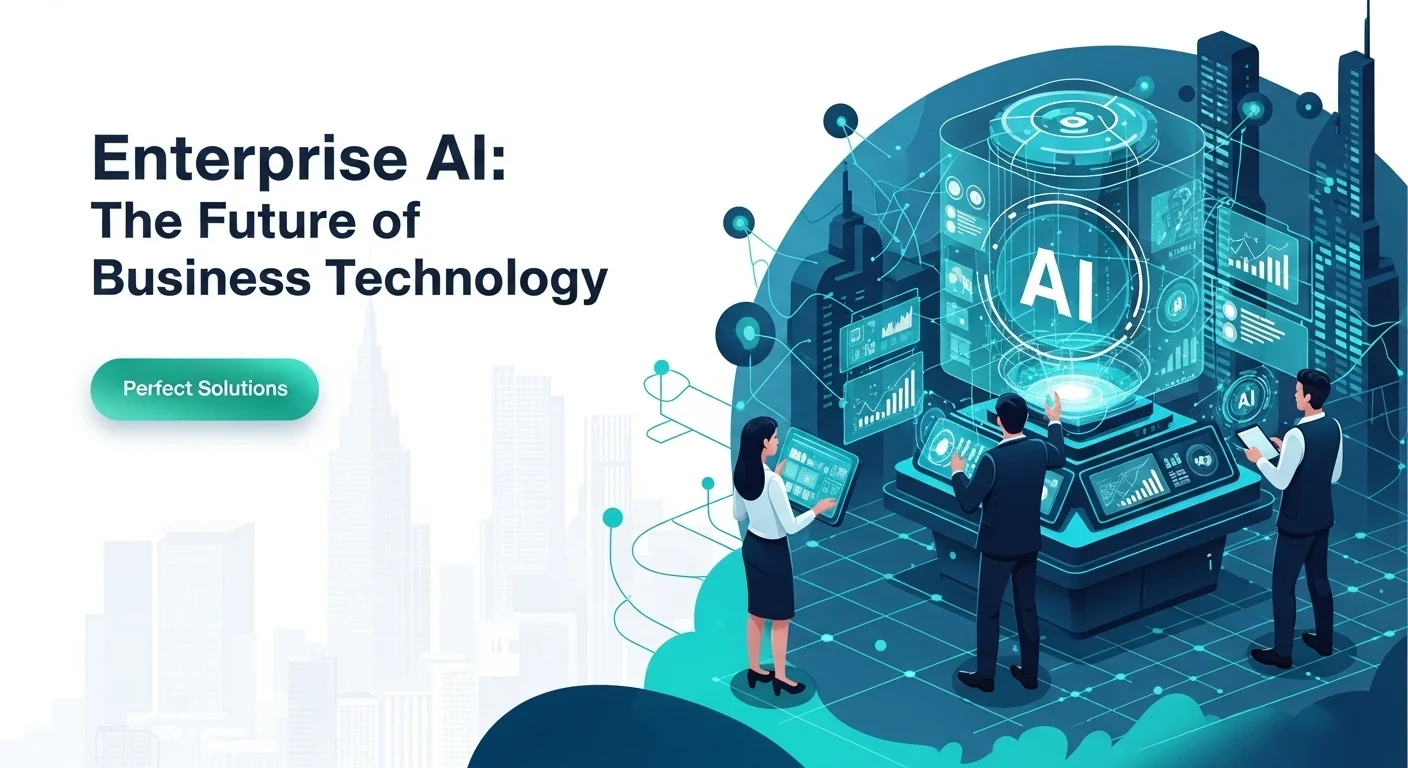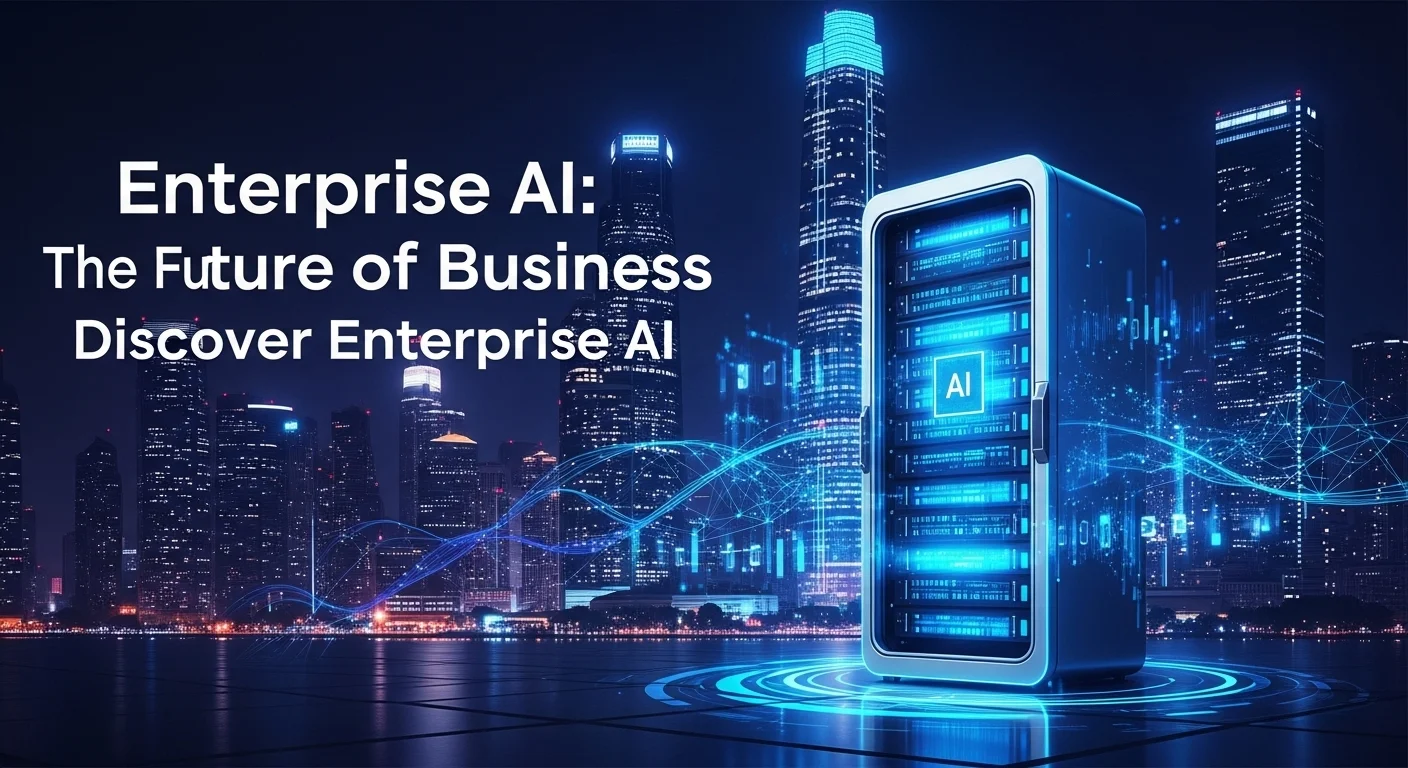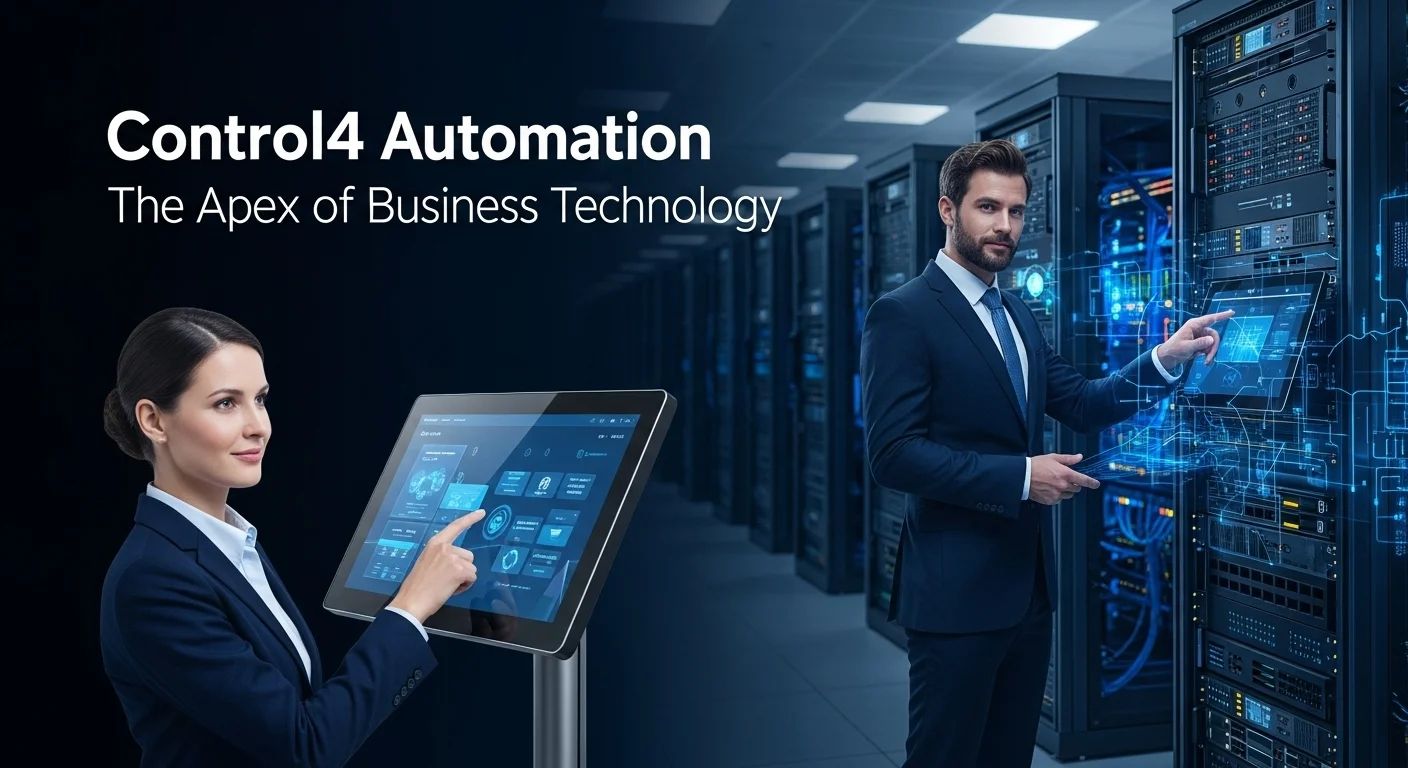Your Practical Guide to Enterprise AI: How It's Really Changing Business

Executive Summary
Ever feel like 'Enterprise AI' is a buzzword everyone uses but few can explain simply? I've spent years in this field, helping companies move from confusion to clarity. This isn't just another tech trend; it's a fundamental shift in how businesses operate. In this guide, I'll break down what this powerful technology is (and isn't), why it's crucial for staying competitive, and how companies are using it to solve real problems. We'll explore everything from the software powering it to the rise of intelligent conversational tools, giving you the practical knowledge you need to understand this transformative force.
Table of Contents
Table of Contents
- What is Enterprise AI and Why Does It Matter?
- How is Corporate AI Different from the AI on Your Phone?
- The Technology Behind Enterprise AI
- Why AI Has Become a Business Imperative
- A Complete Guide to AI in Business Solutions
- Exploring Key Business Applications
- The Rise of Conversational AI in the Workplace
- Tips and Strategies for Your AI Journey
- Navigating the Ethical Maze of AI
- Future-Proofing Your AI Strategy
What is Enterprise Ai and Why Does It Matter?
In the world of business technology, a powerful shift is happening that's changing the game for entire industries: Enterprise AI. But what does that term actually mean? Think of it as the industrial-strength version of the AI you might use every day. At its heart, it's about integrating smart technologies like machine learning (ML), Natural Language Processing (NLP), and computer vision deep into a large organization's core operations. Unlike the AI in your phone's digital assistant, this type is built to solve massive, complex business challenges. It demands a powerful architecture that can handle huge scale, ensure top-notch security, and seamlessly plug into existing corporate systems. This represents a strategic leap from running small AI experiments to adopting a company-wide approach that drives real business value. In my experience, the importance of this shift can't be overstated. It's become essential for any business wanting to innovate, boost efficiency, and keep a competitive edge. Companies that get this right can unlock incredible opportunities, moving from simply reacting to problems to proactively predicting what's next.
How is Corporate AI Different from the AI on Your Phone?
To really get a handle on Enterprise AI, you have to see how it differs from the consumer AI we're all familiar with. Consumer AI, like in Siri or Netflix recommendations, is all about making an individual's life easier or more entertaining. Corporate AI operates in a much more complex world. Here's what sets it apart:
- Scale: Business AI platforms have to process enormous amounts of data and support thousands of employees across different departments all at once. That's a scale most consumer apps never have to deal with.
- Business Context: These systems need a deep, nuanced understanding of the company—its structure, employee roles, access levels, and even internal jargon—to work effectively and securely.
- Deep Integration: A core job for corporate AI is to plug into a complex web of existing business software, like Enterprise Resource Planning (ERP), Customer Relationship Management (CRM), and supply chain tools. It has to work with what's already there.
- Security and Compliance: Working inside a business means playing by strict rules. This includes data governance, privacy laws like GDPR, and industry-specific regulations. Security isn't just a feature; it's a foundation.
- Driven by ROI: At the end of the day, every business AI project is measured by its impact on the bottom line, whether that's cutting costs, growing revenue, reducing risk, or making people more productive.
The Technology Behind Enterprise AI
Enterprise AI isn't one single thing; it’s a whole ecosystem of technologies working together. The engine driving this revolution has a few key parts. Machine learning is the foundation, giving systems the ability to learn from data, spot patterns, and make decisions without a human needing to step in every time. A subset of this, deep learning, uses complex neural networks to power advanced tools for things like image recognition and understanding language. Natural Language Processing (NLP) is another critical piece, letting machines understand and generate human language. This is the magic behind the rise of intelligent conversational tools for business, a field that's completely changing customer service and internal communication. Then there's computer vision, which lets systems understand the visual world. This unlocks powerful uses, like quality control in factories, medical image analysis in hospitals, and inventory checks in retail. These technologies are often delivered through powerful business AI software platforms from leading tech firms. These platforms give companies the tools for managing data, building models, and deploying AI without having to start from scratch.
Why AI Has Become a Business Imperative
In today's market, ignoring Enterprise AI isn't just a missed opportunity; it's a strategic risk. Its importance comes from the real, tangible benefits it delivers across a company. One of the biggest wins I've seen is a huge boost in operational efficiency. By automating repetitive tasks like processing invoices, entering data, or answering routine customer questions, AI frees up your team to focus on bigger, more creative work. This doesn't just cut costs and reduce errors—it makes for happier, more productive employees. On top of that, this technology is a powerhouse for making smarter, data-backed decisions. Big companies create a mind-boggling amount of data. AI systems can sift through these massive datasets at a speed humans could never match, uncovering hidden trends and giving leaders the insights they need to plan strategically. This lets a business be more nimble and quick to react. The customer experience is also being completely transformed. With tools like conversational AI, companies can offer 24/7, personalized support through smart chatbots. These systems can answer questions instantly and create a smoother customer journey. This is where many of the top business AI providers are focusing, building platforms that redefine how a company talks to its customers. Finally, it fuels innovation and opens up new ways to make money. By using predictive analytics or creating new AI-powered services, companies can shake up their industries. As we look ahead, bringing AI into the business isn't just a tech upgrade; it's a fundamental change in how companies operate and create value.

Complete guide to Enterprise Ai in Technology and Business Solutions
Getting Enterprise AI right is more than just knowing it's important; it requires a clear plan for putting it into action and a solid grasp of the solutions out there. This guide is a roadmap for the technical and business steps you need to take to deploy AI effectively and truly transform your operations. I've found that the most successful journeys follow a structured path, broken down into key phases: defining your strategy, getting your data in order, building your models, deploying them, and continuously making them better.
The Enterprise AI Implementation Lifecycle
Bringing AI into a large organization is a complex project that needs careful planning. A structured lifecycle makes sure your AI projects are tied to real business goals and deliver results you can measure.
- Strategy and Business Case: First things first, you need to pinpoint the key business problems AI can solve. This means linking your AI goals to what the business wants to achieve—be it keeping more customers, streamlining the supply chain, or cutting costs. A solid business case with clear key performance indicators (KPIs) is vital for getting everyone on board and proving its worth.
- Data Readiness and Governance: AI runs on data. The success of any project depends on the quality and accessibility of that data. In my experience, this is where most projects stumble. You need to assess your current data landscape, and make sure your data is clean, accurate, and organized. Strong data governance policies are non-negotiable for managing privacy, security, and compliance.
- Model Development and Training: This is where the data scientists and ML engineers get to work, picking the right algorithms and building predictive models. It's a phase that involves a lot of experimentation. The model you choose will depend on the problem you're solving. Many businesses use platforms from leading AI companies to speed this up with pre-built tools.
- Deployment and Integration: A model isn't useful until it's part of your daily workflow. This step, which we call MLOps (Machine Learning Operations), is all about getting the model into a live environment where it can make real-time decisions. It must integrate smoothly with your existing systems for the corporate AI software to work properly.
- Monitoring and Continuous Improvement: AI models aren't a 'set it and forget it' solution. Their performance can drift over time as data changes. That's why you have to keep an eye on them, tracking their performance against your KPIs and retraining them with new data to keep them sharp and valuable.
Exploring Key Business Applications and Solutions
Enterprise AI isn't one-size-fits-all. It has a huge range of applications tailored for different industries. Many of the big names in tech, like IBM, Google, Microsoft, and NVIDIA, offer specialized platforms and services for these sectors.
- In Finance: AI is a game-changer for fraud detection, analyzing transactions in real-time to spot anything suspicious. It's also used in algorithmic trading, assessing credit risk, and powering intelligent chatbots that handle customer banking questions.
- In Healthcare: AI algorithms help radiologists analyze medical images like X-rays to detect diseases earlier. Pharmaceutical companies use it to speed up drug discovery. It also helps create personalized treatment plans and streamline hospital operations.
- In Retail: AI makes supply chains smarter by predicting demand and managing inventory. Personalization engines use it to suggest products to customers, creating that 'they really get me' feeling, while dynamic pricing models adjust to the market in real-time.
- In Manufacturing: Predictive maintenance is a killer app here. Sensors and AI can predict when a machine is about to fail, letting you fix it before it breaks down and causes delays. AI-powered cameras are also used for quality control, spotting tiny defects with superhuman accuracy.
The Rise of Conversational AI in the Workplace
One of the fastest-growing and most impactful areas of this field is conversational AI for business. This tech has come a long way from the clunky, scripted chatbots of the past. Today's conversational platforms use sophisticated NLP to understand context, figure out what you mean, and have surprisingly natural conversations. It's changing how businesses operate both inside and out.
External Use: A New Era for Customer Service
For customer-facing teams, conversational AI is a superpower. Intelligent virtual assistants can handle a huge range of customer requests 24/7, from answering common questions to processing orders. This instant support makes customers happier and frees up human agents to handle the really tough problems that require a human touch.
Internal Use: Making Employees' Lives Easier
Inside the company, these tools act as smart assistants for your team. They can be plugged into the IT helpdesk to handle things like password resets, or into HR systems to answer questions about benefits. This streamlines internal work, cuts down on administrative tasks, and helps everyone get what they need faster, boosting productivity across the board. The market for this technology is exploding, and choosing the right solution means looking at its language skills, how well it integrates, and how much you can customize it for your unique business needs.

Tips and strategies for Enterprise Ai to improve your Technology experience
Adopting Enterprise AI is a huge step, but the path can be tricky. To make sure the journey is smooth and actually improves your business, it's vital to have a smart strategy that focuses on best practices, ethics, and a clear vision for the future. Here are some actionable tips I've learned over the years for any organization starting or scaling its AI efforts.
Best Practices for a Successful AI Implementation
A winning AI strategy is built on a handful of proven practices. Following these can help you avoid common mistakes and get the most out of your investment.
- Start Small, Prove Value: My best advice? Don't try to boil the ocean. Instead of a massive AI overhaul, start with a focused pilot project. Find one specific, painful problem in your business and solve it with a small AI project. A quick win builds incredible momentum and teaches you valuable lessons for larger projects.
- Build a Collaborative Culture: AI is not just an IT project; it’s a business transformation. I've seen the most success when IT teams, data scientists, and the business experts who know the day-to-day operations work together closely. Create a culture that encourages trying new things and sees failures as learning opportunities.
- Invest in Your People: The demand for AI talent is huge. You have to invest in training your current team. This means teaching them about AI concepts, data literacy, and how to use the new AI-powered tools. Partnering with universities or training specialists can be a great way to bridge any skills gaps.
- Data Quality is Everything: I've said it before, but it's worth repeating: Data Quality is Everything. A solid data strategy is non-negotiable. This means having strong governance, making sure your data is clean and easy to access, and breaking down data silos between departments.
- Choose the Right Tools and Partners: The market for business AI software is crowded. You need to carefully decide whether to build your own solutions, buy something off-the-shelf, or team up with a vendor. When picking a partner, look for companies with a proven track record in your industry and a commitment to collaboration.
Navigating the Ethical Maze of AI
As AI gets more powerful, the ethical questions become more important. A responsible AI strategy has to tackle these issues head-on to build trust with customers, employees, and regulators.
- Transparency and Explainability: Sometimes, an AI's decision-making process can feel like a 'black box.' It's important to push for 'explainability,' where the AI's reasoning can be understood by a person. This is especially critical in areas like finance and healthcare, where you have to be able to audit decisions.
- Bias and Fairness: AI models learn from data. If that data has historical biases in it (like gender or racial bias), the model will learn and even amplify them. You have to put processes in place to check your data and models for bias to make sure your AI systems are making fair decisions.
- Data Privacy and Security: These systems often handle sensitive customer and company data. Sticking to the highest standards of privacy and security is a must. This includes strong access controls, encryption, and following regulations like GDPR.
- Human in the Loop: Even with automation, human oversight is still crucial. Set up clear governance, like an AI ethics committee, to oversee how AI is developed and used, making sure it aligns with your company's values. The goal is to enhance human skills, not replace human accountability.
Future-Proofing Your AI Strategy
The field of AI is moving incredibly fast. To stay ahead, you need to be thinking about tomorrow's trends, not just today's technology.
- The Rise of Generative AI: While most business AI has been about prediction, Generative AI is creating new possibilities. This tech can create brand new content, from text and images to computer code. Smart companies are already exploring how to use it for things like hyper-personalized marketing or creating synthetic data to train other models.
- Hyperautomation: This is about combining AI, machine learning, and robotic process automation (RPA) to automate as many business processes as you can. The aim is to build a super-efficient, agile, and intelligent organization.
- AI for Everyone: AI tools are becoming easier to use. Low-code and no-code platforms are letting business users with less technical skill build and deploy their own AI applications. This will speed up innovation across the entire company. For a great deep dive on this, MIT has a fantastic resource: Integrating Generative AI Into Business Strategy.
- Smarter Conversations: The evolution of conversational AI will continue. We're moving towards more sophisticated, emotionally aware assistants that can anticipate what you need and handle complex conversations, further blurring the line between human and machine.
By embracing these strategies and looking ahead, you can unlock the full power of Enterprise AI, turning it from just another piece of tech into a core driver of your company's growth and innovation.
Expert Reviews & Testimonials
Sarah Johnson, Business Owner ⭐⭐⭐
As a business owner, I found this article informative. I just wish there were a few more real-world examples I could directly apply to my own company.
Mike Chen, IT Consultant ⭐⭐⭐⭐
A solid overview of Enterprise AI. It definitely clarified a lot for me as an IT consultant, though a simpler explanation for some of the more technical bits would have been perfect.
Emma Davis, Tech Expert ⭐⭐⭐⭐⭐
Absolutely fantastic article! It’s one of the most comprehensive guides on Enterprise AI I've read. It was a huge help for my specialization, and everything was crystal clear.



